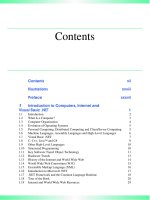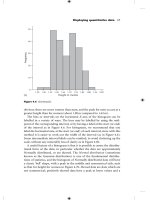Java How to Program, Sixth Edition doc
Bạn đang xem bản rút gọn của tài liệu. Xem và tải ngay bản đầy đủ của tài liệu tại đây (22.47 MB, 7,976 trang )
Java™ How to Program, Sixth
Edition
Table of Contents
Copyright
DeitelR Books, Cyber
Classrooms, Complete Training
Courses and Web-Based
Training Courses published by
Prentice Hall
Preface
Features in Java How to
Program, 6/e
Teaching Approach
Tour of the Book
A Tour of the Optional Case
Study on Object-Oriented
Design with the UML
A Tour of the Optional GUI and
Graphics Case Study
Software Included with Java
How to Program, 6/e
Teaching Resources for Java
How to Program, 6/e
Java in the Lab
OneKey, CourseCompassSM,
WebCT™ and by
Blackboard™
Java 2 Multimedia Cyber
Classroom, 6/e Through
OneKey
PearsonChoices
Computer Science AP Courses
DeitelR Buzz Online Free E-
mail Newsletter
Acknowledgments
About the Authors
About Deitel & Associates, Inc.
Before You Begin
Software and Other Resources
on the CD That Accompanies
Java How to Program, Sixth
Edition
Hardware and Software
Requirements to Run JDK 5.0
Copying and Organizing Files
Copying the Book Examples
from the CD
Changing the Read-Only
Property of Files
Installing the J2SE
Development Kit (JDK)
Setting the PATH Variable
Chapter 1. Introduction to
Computers, the Internet and the
World Wide Web
Section 1.1. Introduction
Section 1.2. What Is a
Computer?
Section 1.3. Computer
Organization
Section 1.4. Early Operating
Systems
Section 1.5. Personal,
Distributed and Client/Server
Computing
Section 1.6. The Internet and
the World Wide Web
Section 1.7. Machine
Languages, Assembly
Languages and High-Level
Languages
Section 1.8. History of C and
C++
Section 1.9. History of Java
Section 1.10. Java Class
Libraries
Section 1.11. FORTRAN,
COBOL, Pascal and Ada
Section 1.12. BASIC, Visual
Basic, Visual C++, C# and
.NET
Section 1.13. Typical Java
Development Environment
Section 1.14. Notes about Java
and Java How to Program,
Sixth Edition
Section 1.15. Test-Driving a
Java Application
Section 1.16. Software
Engineering Case Study:
Introduction to Object
Technology and the UML
(Required)
Section 1.17. Wrap-Up
Section 1.18. Web Resources
Summary
Terminology
Self-Review Exercises
Answers to Self-Review
Exercises
Exercises
Chapter 2. Introduction to Java
Applications
Section 2.1. Introduction
Section 2.2. First Program in
Java: Printing a Line of Text
Section 2.3. Modifying Our
First Java Program
Section 2.4. Displaying Text
with printf
Section 2.5. Another Java
Application: Adding Integers
Section 2.6. Memory Concepts
Section 2.7. Arithmetic
Section 2.8. Decision Making:
Equality and Relational
Operators
Section 2.9. (Optional)
Software Engineering Case
Study: Examining the
Requirements Document
Section 2.10. Wrap-Up
Summary
Terminology
Self-Review Exercises
Answers to Self-Review
Exercises
Exercises
Chapter 3. Introduction to
Classes and Objects
Section 3.1. Introduction
Section 3.2. Classes, Objects,
Methods and Instance Variables
Section 3.3. Declaring a Class
with a Method and Instantiating
an Object of a Class
Section 3.4. Declaring a
Method with a Parameter
Section 3.5. Instance Variables,
set Methods and get Methods
Section 3.6. Primitive Types vs.
Reference Types
Section 3.7. Initializing Objects
with Constructors
Section 3.8. Floating-Point
Numbers and Type double
Section 3.9. (Optional) GUI and
Graphics Case Study: Using
Dialog Boxes
Section 3.10. (Optional)
Software Engineering Case
Study: Identifying the Classes in
a Requirements Document
Section 3.11. Wrap-Up
Summary
Terminology
Self-Review Exercises
Answers to Self-Review
Exercises
Exercises
Chapter 4. Control Statements:
Part I
Section 4.1. Introduction
Section 4.2. Algorithms
Section 4.3. Pseudocode
Section 4.4. Control Structures
Section 4.5. if Single-Selection
Statement
Section 4.6. if else Double-
Selection Statement
Section 4.7. while Repetition
Statement
Section 4.8. Formulating
Algorithms: Counter-Controlled
Repetition
Section 4.9. Formulating
Algorithms: Sentinel-Controlled
Repetition
Section 4.10. Formulating
Algorithms: Nested Control
Statements
Section 4.11. Compound
Assignment Operators
Section 4.12. Increment and
Decrement Operators
Section 4.13. Primitive Types
Section 4.14. (Optional) GUI
and Graphics Case Study:
Creating Simple Drawings
Section 4.15. (Optional)
Software Engineering Case
Study: Identifying Class
Attributes
Section 4.16. Wrap-Up
Summary
Terminology
Self-Review Exercises
Answers to Self-Review
Exercises
Exercises
Chapter 5. Control Statements:
Part 2
Section 5.1. Introduction
Section 5.2. Essentials of
Counter-Controlled Repetition
Section 5.3. for Repetition
Statement
Section 5.4. Examples Using
the for Statement
Section 5.5. do while
Repetition Statement
Section 5.6. switch Multiple-
Selection Statement
Section 5.7. break and continue
Statements
Section 5.8. Logical Operators
Section 5.9. Structured
Programming Summary
Section 5.10. (Optional) GUI
and Graphics Case Study:
Drawing Rectangles and Ovals
Section 5.11. (Optional)
Software Engineering Case
Study: Identifying Objects'
States and Activities
Section 5.12. Wrap-Up
Summary
Terminology
Self-Review Exercises
Answers to Self-Review
Exercises
Exercises
Chapter 6. Methods: A Deeper
Look
Section 6.1. Introduction
Section 6.2. Program Modules
in Java
Section 6.3. static Methods,
static Fields and Class Math
Section 6.4. Declaring Methods
with Multiple Parameters
Section 6.5. Notes on Declaring
and Using Methods
Section 6.6. Method Call Stack
and Activation Records
Section 6.7. Argument
Promotion and Casting
Section 6.8. Java API Packages
Section 6.9. Case Study:
Random-Number Generation
Section 6.10. Case Study: A
Game of Chance (Introducing
Enumerations)
Section 6.11. Scope of
Declarations
Section 6.12. Method
Overloading
Section 6.13. (Optional) GUI
and Graphics Case Study:
Colors and Filled Shapes
Section 6.14. (Optional)
Software Engineering Case
Study: Identifying Class
Operations
Section 6.15. Wrap-Up
Summary
Terminology
Self-Review Exercises
Answers to Self-Review
Exercises
Exercises
Chapter 7. Arrays
Section 7.1. Introduction
Section 7.2. Arrays
Section 7.3. Declaring and
Creating Arrays
Section 7.4. Examples Using
Arrays
Section 7.5. Case Study: Card
Shuffling and Dealing
Simulation
Section 7.6. Enhanced for
Statement
Section 7.7. Passing Arrays to
Methods
Section 7.8. Case Study: Class
GradeBook Using an Array to
Store Grades
Section 7.9. Multidimensional
Arrays
Section 7.10. Case Study: Class
GradeBook Using a Two-
Dimensional Array
Section 7.11. Variable-Length
Argument Lists
Section 7.12. Using Command-
Line Arguments
Section 7.13. (Optional) GUI
and Graphics Case Study:
Drawing Arcs
Section 7.14. (Optional)
Software Engineering Case
Study: Collaboration Among
Objects
Section 7.15. Wrap-Up
Summary
Terminology
Self-Review Exercises
Answers to Self-Review
Exercises
Exercises
Special Section: Building Your
Own Computer
Chapter 8. Classes and Objects:
A Deeper Look
Section 8.1. Introduction
Section 8.2. Time Class Case
Study
Section 8.3. Controlling Access
to Members
Section 8.4. Referring to the
Current Object's Members with
the this Reference
Section 8.5. Time Class Case
Study: Overloaded Constructors
Section 8.6. Default and No-
Argument Constructors
Section 8.7. Notes on Set and
Get Methods
Section 8.8. Composition
Section 8.9. Enumerations
Section 8.10. Garbage
Collection and Method finalize
Section 8.11. static Class
Members









